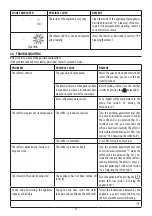
32
Danger of burns!
Interrupt steam delivery before removing the container with the
frothed milk to avoid burns caused by splashes of boiling milk.
10. Add the milk froth to the coffee prepared previously. The
cappuccino is ready. Sweeten to taste and, if desired, sprin-
kle the froth with a little cocoa powder.
Please note!
If “Energy saving” is active, you may have to wait a few seconds
before steam is delivered.
17.1 Cleaning the cappuccino maker after use
Clean the cappuccino maker (A18) each time you use it to avoid
the build-up of milk residues or blockages.
Danger of burns!
When cleaning the cappuccino maker, a little hot water is de-
livered. Take care to avoid contact with splashes of hot water.
1. Deliver a little water by turning the steam/hot water dial
(A21) to the
I
position. Then stop delivery by turning the
dial back to the
0
position.
2. Wait a few minutes for the cappuccino maker to cool down.
Turn the cappuccino maker downwards to remove it (fig.
19).
3. Models with adjustable cappuccino maker only:
Move the ring (A20) upwards until the hole shown in fig.
20 is uncovered.
4. Remove the nozzle (A19) downwards (fig. 21).
5. Make sure the two holes shown by the arrow in fig. 22 are
not blocked. If necessary, clean with a pin.
6. Reinsert the nozzle and replace the cappuccino maker
on the nozzle, pushing it upwards and turning it until it is
attached.
18. DELIVERING HOT WATER
Important! Danger of scalding.
Never leave the machine unattended when hot water is re-
leased. The spout of the cappuccino maker (A18) becomes hot
during delivery.
1. Place a container under the cappuccino maker (as close as
possible to avoid splashes).
2. Turn the steam/hot water dial (A21) to the
I
position (fig.
6).
3. To stop hot water delivery manually, turn the steam/hot
water dial to the
0
position.
Please note!
If “Energy Saving” is active, you may have to wait a few seconds
before hot water and steam are delivered..
19. CLEANING
19.1 Cleaning the machine
The following parts of the machine must be cleaned regularly:
- internal circuit of the machine;
- coffee grounds container (A13);
- drip tray (A14), drip tray grille* (A15) and condensate tray
(A12);
- water tank (A7);
- coffee spouts (A11);
- cappuccino maker (A18) (“19. Cleaning”);
- pre-ground coffee funnel (A4);
- infuser (A9), accessible after opening the infuser door (A8);
- control panel (B).
Important!
• Do not use solvents, abrasive detergents or alcohol to clean
the coffee machine. With De’Longhi superautomatic coffee
machines, no chemical products are required for cleaning
purposes.
• None of the components of the appliance can be washed
in a dishwasher with the exception of the drip tray grille*
(A15).
• Do not use metal objects to remove encrustations or coffee
deposits as they could scratch metal or plastic surfaces.
19.2 Cleaning the internal circuit
If the appliance is not used for more than 3/4 days, before using
it again, we strongly recommend switching it on and:
- 2/3 rinse cycles by pressing
(B5);
- delivering hot water for a few seconds (section “18. Deliv-
ering hot water”).
Please note:
After cleaning, it is normal for the grounds container (A13) to
contain water.
19.3 Cleaning the coffee grounds container
When the light (flashes, the coffee grounds container (A13)
must be emptied and cleaned. The appliance cannot be used to
make coffee until you have cleaned the grounds container. Even
if not full, the empty grounds container message is displayed 72
hours after the first coffee has been prepared. For the 72 hours
to be calculated correctly, the machine must never be turned off
with the main switch (A6).
Important! Danger of scalding
If you make a number of cappuccinos one after the other, the
metal cup tray (A17) becomes hot. Wait for it to cool down be-
fore touching it and handle it from the front only.
To clean (with the machine on):
• Remove the drip tray (A14) (fig. 23), empty and clean.








































